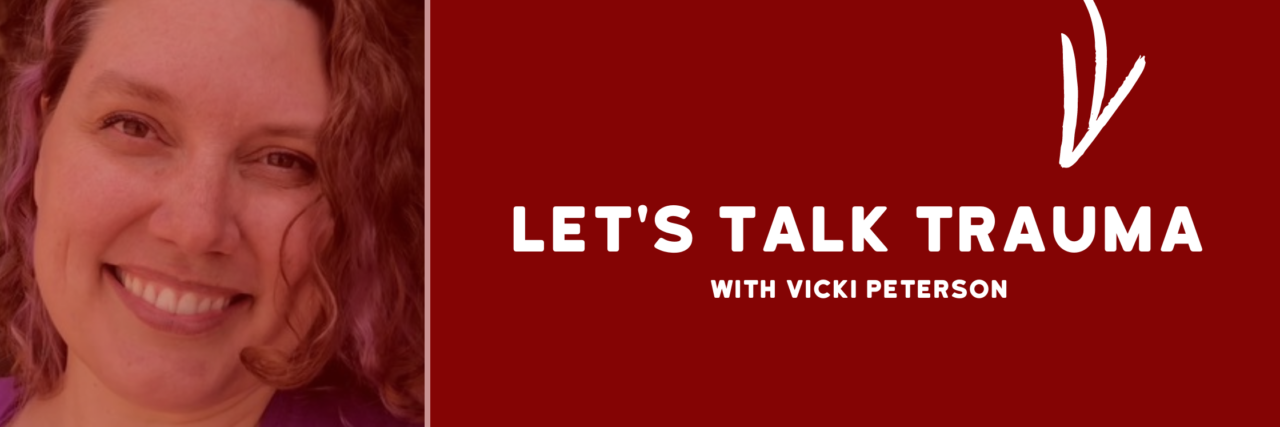Let's Talk Trauma: I'm Traumatized, Now What Do I Do?
Editor's Note
Follow Vicki’s weekly trauma column “Let’s Talk Trauma” by following her on The Mighty!
Recognizing the lifelong impact of trauma can feel like an epiphany. I’ve always carried some belief that my childhood experiences were “not great,” but it wasn’t until I was in my forties and logged over ten years of no contact with my abusers that I “discovered” that I live with complex post traumatic stress disorder (PTSD) from childhood psychological and sexual abuse. For me, searching for the source of my stress-related health issues led me to a truth that had been hiding in plain sight all along. I had been minimizing and denying its effects since, well, birth. I’ve since learned that the experience of “discovering” the impact of trauma later in life is common among childhood abuse survivors, largely because our abusers were telling us that our experience was invalid. Young, old or in-between, trauma recovery often starts with a realization that things are not what they seem.
In Poetics, an ancient Greek text credited as a foundational influence on Western storytelling, Aristotle referred to this type of experience as “recognition: a change from ignorance to knowledge, disclosing either a close relationship or enmity, on the part of the people marked out for good or bad fortune.” Aristotle used the example of the play, Oedipus Rex, where Oedipus experienced a moment of “recognition” that he inadvertently carried out what the oracle prophesied: he killed his father and married his own mother. Recognition leads to major changes in one’s life, both internal and external.
So, when a trauma survivor has an “Aha moment,” what’s next?
Trauma recovery work is multifaceted, and it can get tricky to find just the right combination of resources for healing. Because we all experience trauma differently, recovery often means a lot of trial and error to find what personally works best.
Trauma recovery typically consists of three repetitive cycles: identify, process and release.
Identify
Denial and minimization are common coping mechanisms that make identifying trauma difficult. Sometimes it might feel like living in a fog. Moving from the thought, “It wasn’t that bad,” to “Yeah, actually it was that bad” is a major hurdle for trauma recovery. Imagine a toddler who falls and scrapes his knee, and the mother tells him, “You’re okay!” Even though he feels pain, the toddler believes the mother and doesn’t cry. In the moment, this seemingly harmless exchange might prevent a toddler meltdown. However, when this same pattern of suppression gets applied to bigger hurts later in life, thinking “I’m okay!” instead of, “This hurts!” when we feel pain prevents us from being able to properly identify what’s really going on in our minds and bodies. What triggers us and causes pain is then relegated to our subconscious, where it becomes even more difficult to pinpoint and continues to run the show. When we are cut off from our own feelings of hurt and pain, we become reactive, not proactive, in our responses. Taking ownership of our true thoughts and feelings is a major step.
Process
What often comes next for trauma survivors in recovery is a tsunami of suppressed emotions, which may range from anger to grief. When we are out of practice from feeling the full range of our feelings, the experience of rediscovering them might seem scary. For this reason, trauma recovery work must be done in an environment that is completely safe, emotionally and physically. This work may be done with a therapist certified in trauma recovery who has established trust, or with a safely bonded partner. Trauma that is rooted in toxic relationships typically needs safe relationships anchoring the trauma survivor while they process. Processing previously suppressed feelings might come in waves, but typically it is most intense just after a period of discovery or recognition. Once the initial floodgate opens, the experience of feeling previously suppressed feelings becomes a little easier each time something comes up. Trauma recovery is learning to ride the waves.
Release
Releasing trauma that has been previously locked away is often harder than it seems. It’s common for trauma survivors to be so afraid of the processing phase that they trick themselves back into minimization and denial, feeling “fine” when they are not, and thinking they’re “over it” when they are not. Inevitably, their unhealed trauma returns, and they continue to be triggered by the same issues. Releasing trauma can be done physically, through techniques such as yoga, exercises that target the vagus nerve or massage. Release is also processed emotionally, through self-expression, communicating boundaries or bonding with a safe person. There are many techniques, support groups, and therapies that can aid in processing and releasing trauma. Typically, multiple layers each need to be processed and released before reaching the next layer. The success of fully releasing trauma usually depends on how far one is willing to go in emotionally processing it. If it’s not fully healed, it will return to be processed again, usually with less intensity, until eventually there is no emotional charge to it anymore. With each new cycle, trauma survivors learn to be gentle with themselves when an issue returns for processing. When a trauma survivor can look directly at the issues that used to trigger them and acknowledge the truth without feeling pain, release has occurred.
Trauma recovery cannot be tricked, cajoled or rushed. It is a journey in learning how to be patient with oneself, and learning to embrace every aspect, especially the parts that seemed previously difficult to love.
Lead image courtesy of contributor

